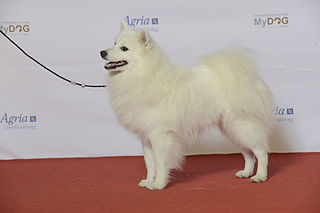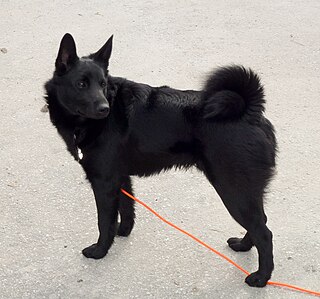
The Swedish Vallhund, also known as the Västgötaspets and Swedish cow dog, is a breed of dog native to Sweden. The breed's name, Vallhund, when translated into English, means herding dog, as the Swedish Vallhund was originally bred as a drover and herder of cows over 1,000 years ago. In 1942, the dog came close to extinction, but careful breeding and publicity by Swedish national Björn von Rosen and K. G. Zettersten managed to revive the breed in popularity and save it from its likely end. In 1943, the Swedish Kennel Club recognized the Swedish Vallhund as a breed, and officially categorized the Swedish Vallhund as "the Västgötaspets" for Västergötland, the province in which their revival took place. Since then, the breed has been recognized by, and bred in, over ten countries and has gained some popularity.

The Jämthund, also called the Swedish Elkhound, is a breed of dog of the Spitz type that is found in Northern Europe. The Jämthund is eponymous with Jämtland, a province in the middle of Sweden.

The Saarloos Wolfdog is a wolf-dog breed originating from the Netherlands by the crossing of a German Shepherd with a Siberian grey wolf in 1935. The offspring were then further crossed with German Shepherds.

Collies form a distinctive type of herding dogs, including many related landraces and standardized breeds. The type originated in Scotland and Northern England. Collies are medium-sized, fairly lightly-built dogs, with pointed snouts. Many types have a distinctive white color over the shoulders. Collies are very active and agile, and most types of collies have a very strong herding instinct. Collie breeds have spread through many parts of the world, and have diversified into many varieties, sometimes mixed with other dog types.

The Finnish Spitz is a breed of dog originating in Finland. The breed was originally trained to hunt all types of game from squirrels and other rodents to bears. It is a "bark pointer", indicating the position of game by barking, and drawing the game animal's attention to itself, allowing an easier approach for the hunter. Its original game hunting purpose was to point to game that fled into trees, such as grouse, and capercaillies, but it also serves well for hunting elk. Some individuals have even been known to go after a bear. In its native country, the breed is still mostly used as a hunting dog. The breed is typically friendly and good with children, so it is suitable for domestic life. The Finnish Spitz has been the national dog of Finland since 1979.

The Norwegian Elkhound is one of the Northern Spitz-type breeds of dog and is the National Dog of Norway. The Elkhound has served as a hunter, guardian, herder, and defender. It is known for its courage in tracking and hunting elk and other large game, such as bears or wolves. The Norwegian Elkhound was first presented at a dog exhibition in Norway in 1877.

The Karelian Bear Dog is a Finnish breed of dog. In its home country, it is seen by many as a national treasure. Karelian Bear Dogs will hunt a variety of animals. Its quick reflexes and fearless nature have made it very popular for hunting large game including brown bears, moose, and wild boar. It was the breed's ability to hunt bears that earned the breed its name. The Karelian Bear Dog is among the top 10 most common dog breeds in Finland.

The Norwegian Buhund is a breed of dog of the spitz type. It is closely related to the Icelandic Sheepdog and the Jämthund. The Buhund is used as a watch dog and an all purpose farm and herding dog.

The Carolina dog, also known as a yellow dog, yaller dog, American dingo, or Dixie dingo, is a breed of medium-sized dog occasionally found feral in the Southeastern United States, especially in isolated stretches of longleaf pines and cypress swamps. Efforts to establish them as a standardized breed have gained the Carolina Dog breed recognition in two smaller kennel clubs and full acceptance into the breed-establishment program of one major kennel club.

The Japanese Spitz is a small to medium breed of dog of the Spitz type. There are varying standards around the world as to the ideal size of the breed, but they are always larger than their smaller cousins, the Pomeranian. They were developed in Japan in the 1920s and 1930s by breeding a number of other Spitz type dog breeds together. They are recognized by the vast majority of the major kennel clubs, except the American Kennel Club due to it being of similar appearance to the white Pomeranian, American Eskimo Dog and Samoyed. While they are a relatively new breed, they are becoming widely popular due to their favorable temperament and other features.

The Pumi is a medium-small breed of sheep dog from Hungary. They are versatile stock dogs equally adept at gathering, driving and keeping stock under control. They have a long head with semi-erect ears, a whimsical expression, and a tail that forms a circle over the back. The coat is a combination of wavy and curly hair forming curls all over the body.

The Eurasier, or Eurasian, is a spitz type breed of dog that originated in Germany through cross-breeding between popular European and Asian Spitz. It is widely known as a wonderful companion that maintains its own personality, has a dignified reserve with strangers, has a strong bond to its family, and is relatively easy to train.

The Finnish Lapphund –Finnish: Suomen Lapinkoira– is a hardy, easy going, medium-size breed of Spitz type. Traditionally it has been used for herding reindeer. Although it is one of the most popular dog breeds in its native country, Finland, it is not very numerous outside of the Nordic countries.

The Black Norwegian Elkhound is a small Spitz breed classified by the FCI as a hunting dog. It is currently an uncommon breed in Norway and very rare outside the Nordic countries of Scandinavia. It is a sibling breed to a Grey Norwegian Elkhound, but is smaller, more agile, doesn't bark and was bred explicitly for on-leash dog hunting.

The Swedish Lapphund is a breed of dog of the Spitz type from Sweden, one of three Lapphund breeds developed from a type of dog used by the Sami people for herding and guarding their reindeer. The expression "the black beauty of Norrland" is very often attributed to the Swedish lapphund, which is most likely one of Sweden's oldest breeds.

Podenco Canario is a breed of dog from the Canary Islands. The Podenco Canario is still used today, primarily in packs, most often for the sport hunting of rabbits. The word "podenco" in Spain refers to a certain type of dog, typically rabbit hunters with the same body shape. "Canario" is a reference to its region of origin, the Canary Islands. The Spanish Kennel Club, Real Sociedad Canina de España, recognises the following similar dog breeds that use the identifier "podenco" in their names: Podenco Andaluz, Podenco Ibicenco, and Podenco Valenciano. ge

The Karelo-Finnish Laika is a breed of spitz-type dog from the Karelia area of Russia.

Hällefors Elkhound is a Swedish dog breed.
The Lapponian Shepherd (Lapinpaimenkoira) or Cockhill's Finnish Lapphound (Kukonharjunkoira) is an extinct dog breed originating from Finland. Despite its name, it did not come from Lapland, but from the southern parts of the country.

The Nenets Herding Laika also known as the reindeer spitz or olenegonka, is an aboriginal spitz landrace of dog originating from the Yamalo-Nenets Autonomous Okrug, in Russia. Unlike other laikas, Nenets Herding Laika are less commonly used for hunting. Instead they have been selected primarily for reindeer herding ability, originally by the Nenets people, and later by reindeer herders through Russia. Nenets herding laika are thought to be the progenitor of several modern breeds, the most well-documented being the Samoyed. Despite this, the breed almost died out during the Soviet era due to lack of interest in preserving genetically purebred examples. In 1994, the Russian Kynologic Federation (RKF) approved the first official standard of the breed.



















